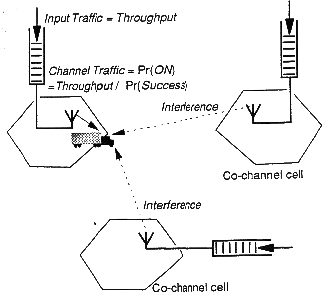
Performance of Packet Data Networks
It cannot be assumed that such cellular structures optimized for
non-blocking voice circuits are also optimal for a mobile network of virtual
circuits between users who are prepared to accept delays of their data
packets.
- It is the link outage probability, as determined by unacceptable co-channel
interference between cells, that determines the optimum design and real-time
capacity of optimum cellular telephone networks. Although digital modulation
schemes can be made more robust to interference than analog modulation, they
still require considerable spacing between cells using the same radio
frequencies, in order to avoid unacceptable degradation of voice circuits too
often.
- Users of packet data protocols are quite willing to accept a significant
risk of harmful collisions between coinciding packets, in return for not
having to schedule their bursty accesses very strictly or to defer
transmission for a long time. Packet protocols are designed to repair any
harmful interference between packets simply by retransmission. This contrasts
with classical fixed and mobile telephone circuit requirements, which contain
substantial a-priori guarantees against occasional circuit outages, including
those due to harmful interference.
When computer users are prepared to gamble against the risk of mutual conflicts
in order to reap the benefit of lower average delay, they can also adopt a more
tolerant attitude to the additional random vagaries of the mobile radio channel.
Moreover, such users prepared to accept occasional mutual conflicts between their
accesses may find it counterproductive to invoke the strict power
control assumed in mobile telephone systems: If access powers are very unequal
among competing signals, there is a better chance that at least one competitor
wins the contest for the receiver (capture), than
in the event of perfectly balanced signals, which will all annihilate each other
in a collision. Research has shown that this effect causes mobile packet-data
random-access networks to have a higher throughput
than predicted by conventional models used for wireline networks.

Figure: One of the objectives in a cellular data network is to
minimize the waiting time in the packet buffer of base station.
It appears that for many data networks with bursty traffic, the optimum reuse
pattern is to use the same channel in all cells. This has been verified by calculations
for the uplink and the downlink.






